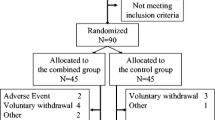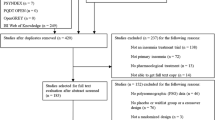Abstract
Objective: To assess the efficacy and safety of zolpidem administered on an ‘as needed’ basis for 4 weeks in primary insomnia.
Design: Multicentre, double-blind, randomised, placebo-controlled study.
Setting: 58 primary care centres in France.
Patients and Participants: 245 individuals with primary insomnia.
Methods: Following a placebo run-in period, patients were given four tablets containing either placebo or zolpidem 10mg and were instructed to take one tablet on the first two nights, the two remaining tablets to be taken when required throughout the week. This was followed by a 3-week period during which patients were provided with placebo or zolpidem but advised to use as few tablets as possible.
Results: Premature withdrawals due to inefficacy were significantly more common with placebo than with zolpidem (5% vs 0%; p = 0.01). At the end of the study, total sleep time was increased in both groups, the difference being slightly more marked in the zolpidem group (74.6 vs 63.2 minutes; p = nonsignificant). Zolpidem was significantly (p < 0.05) more effective than placebo with respect to sleep quality, daytime drowsiness, quality of life and Clinical Global Impression scales. Safety was comparable in both groups, as was drug consumption, suggesting a lack of any drug-seeking behaviour.
Conclusion: Zolpidem administered ‘as needed’ is a feasible, well tolerated and promising additional option for the management of primary insomnia.







Similar content being viewed by others
References
Mellinger GD, Balter MB, Uhlenhuth EH. Insomnia and its treatment prevalence and correlates. Arch Gen Psychiatry 1985; 42(3): 225–32
Ford DE, Kamerow DB. Epidemiologic study of sleep disturbances and psychiatric disorders. JAMA 1989; 262(11): 1479–84
National Sleep Foundation. Sleep in America: a national survey of US adults. Princeton (NJ): The Gallup Organisations, 1995
Ohayon M, Caulet M. Psychotropic medication and insomnia complaints in two epidemiological studies. Can J Psychiatry 1996; 41(7): 457–64
Morin CM. Insomnia: psychological assessment and management. New York: Guildford Press, 1993
Ustün TB, Privett M, Lecrubier Y, et al. Form, frequency and burden of sleep problems in general health care: a report from the WHO collaborative study on psychological problems in general health care. Eur Psychiatry 1996; 11Suppl. l: 5s–10s
Dement W, Pelayo R. Public health impact and treatment of insomnia. Eur Psychiatry 1997; 12Suppl. 1: 31s–9s
Angst J, Vollrath M, Koch R, et al. The Zurich Study. VII. Insomnia: symptoms, classification and prevalence. Eur Arch Psychiatry Neurol Sci 1989; 238: 285–93
Roth T, Puech A, Paiva T. Zolpidem —place in therapy. In: Freeman H, Puech AJ, Roth T, editors. Zolpidem: an update of its pharmacological properties and therapeutic place in the management of insomnia. Paris: Elsevier, 1996: 215–30
Holm KJ, Goa KL. Zolpidem: an update of its pharmacology, therapeutic efficacy and tolerability in the treatment of insomnia. Drugs 2000; 59(4): 865–89
Benavides J, Abadie P, Baron JC, et al. Comparative in vivo and in vitro selectivity of zolpidem for (benzodiazepine) modulatory site subtypes. Dev Nucl Med (PET for Drug Development and Evaluation) 1995; 26: 109–22
Abadie P, Rioux P, Scatton B, et al. Central benzodiazepine receptor occupancy by zolpidem in the human brain as assessed by positron emission tomography. Eur J Pharmacol 1996; 295(1): 35–44
Sanger D, Depoortere H. The pharmacology and mechanism of action of zolpidem. CNS Drug Reviews 1999; 4(4): 323–40
Fraisse J, Garrigou-Gadenne D, Thénot JP. Pharmacokinetic and metabolic profiles of zolpidem. In: Freeman H, Puech AJ, Roth T, editors. Zolpidem: an update of its pharmacological properties and therapeutic place in the management of insomnia. Paris: Elsevier, 1996: 45–58
Vogel G, Thumond A, Macintosh M, et al. The effect of zolpidem on transient insomnia. Sleep Res 1988; 17: 67
Dockhorn RJ, Dockhorn DW. Zolpidem in the treatment of short-term insomnia: a randomised placebo-controlled clinical trial. Clin Neuropharmacol 1996; 19(4): 333–40
Morgan PJ, Chapados R, Chung FF, et al. Evaluation of zolpidem, triazolam and placebo as hypnotic drugs the night before surgery. J Clin Anesth 1997; 9(2): 97–102
Vogel G, Scharf M, Walsh J, et al. Effects of chronically administered zolpidem on the sleep of healthy insomniacs. Sleep Res 1989; 18: 80
Lahmeyer H, Doherty J, Fillingim J, et al. The effect of zolpidem in outpatients with chronic insomnia. Sleep Res 1990; 19: 70
Fleming J, Moldofsky H, Walsh JK, et al. Comparison of the residual effects and efficacy of short-term zolpidem, flurazepam and placebo in patients with chronic insomnia. Clin Drug Invest 1995; 9(6): 303–13
Merlotti L, Roehrs T, Koshorek G, et al. The dose effects of zolpidem on the sleep of healthy normals. J Clin Psycho-pharmacol 1989; 9(1): 9–14
Parrino L, Terzano MG. Polysomnographic effects of hypnotic drugs, a review. Psychopharmacology 1996; 126(1): 1–16
Soldatos CR, Dikeos D, Whitehead A. Tolerance and rebound insomnia with rapidly eliminated hypnotics: a meta-analysis of sleep laboratory studies. Int Clin Psychopharmacol 1999; 14(5): 287–303
Costa E, Silva JA, Chase M, et al. Special report from a symposium held by the World Health Organization and the World Federation of Sleep Research Societies: an overview of insomnias and related disorders-recognition, epidemiology and rational management. Sleep 1996; 19(5): 412–6
American Psychiatric Association. Diagnostic and statistical manual of mental disorders. 4th ed. Washington (DC): American Psychiatric Association, 1994
Johns MW. A new method for measuring daytime sleepiness: the Epworth sleepiness scale. Sleep 1991; 14(6): 540–5
Lipman RS. Differentiating anxiety and depression in anxiety disorders: use of rating scales. Psychopharmacol Bull 1982; 18(4): 69–77
Raskin A, Schulterbrandt J, Reating N, et al. Replication of factors of psychopathology in interview, word behaviour and self-report ratings of hospitalized depressives. J Nerv Ment Dis 1969; 148(1): 87–98
Guy W. ECDEU Assessment manual for psychopharmacology, revised 1976. Rockville (MD): National Institute of Mental Health, Psychopharmacology Research Branch, 1976; 53: 217–22,313-31
Ware JE. SF-36 health survey. Manual and interpretation guide. Boston (MA): The Health Institute, New England Medical Center, 1993
Stewart AL, Ware JE, editors. Measuring functioning and well-being. The Medical Outcomes Study approach. Durham and London: Duke University Press, 1992
Gillin JC, Byerley WF. The diagnosis and treatment of insomnia. N Engl J Med 1990; 322(4): 239–48
Roehrs T, Vogel G, Roth T. Rebound insomnia: its determinants and significance. Am J Med 1990; 88Suppl. 3A: 39S–42S
Hajak G. Insomnia in primary care. Sleep 2000; 23Suppl. 3: S54–S63
Walsh JK, Roth T, Jamieson A, et al. Intermittent use of zolpidem for the treatment of primary insomnia. Sleep 2000; 23Suppl. 2: A86
Darcourt G, Pringuey D, Sallière D, et al. The safety and tolerability of zolpidem —an update. J Psychopharmacol 1999; 13(1): 81–93
Allain H, Patat A, Lieury A, et al. Comparative study of the effects of zopiclone (7.5 mg), zolpidem, flunitrazepam and a placebo on nocturnal cognitive performance in healthy subjects, in relation to pharmacokinetics. Eur Psychiatry 1995; 10Suppl. 3: 129s–35s
Cluydts R, Peeters K, de Bouyalsky I, et al. Comparison of continuous versus intermittent administration of zolpidem in chronic insomniacs: a double-blind randomised pilot study. J Int Med Res 1998; 26(1): 13–24
Lasagna L. Over-the-counter hypnotics and chronic insomnia in the elderly. J Clin Psychopharmacol 1995; 15(6): 383–6
Acknowledgements
The authors gratefully acknowledge the participation of the Zolpidem Study group: P. Beignot Devalmont, E. Bin, B. Bougeard, G. Boulenge, P. Boyer, J.-M. Brasser, C. Burguier, A. Campagne, J. Castellani, C. Cazes, P. Chapelain, G. Chastan, P. Chazot, F. Chopart, L. Choteau, I. Compagnon, J.-J. Crappier, M.-C. Dalle-Rive, J. David, G. Delamare, G. Duffaut, M. Duret-Rolland, N. Ecochard Cirica, R. Eoche, J.-M. Euvrard, G. Faugas, A. Fortis, D. Frenehard, J.-L. Gabrielli, M.-E. Garros, B. Gautier, R. Gaveau, G. Girardier, V. Guinot, G. Guist’Hau, M. Herne, P. Jallon, O. Jousset, C. Lannier, A. Le Guhennec, J. Lefrançois, J.-F. Massiani, D. Meker, P. Montandrau, G.M. Paillard, J. Peluau, A. Ponsot, M. Pozo, H. Pradere, M. Ripoli, J.-M. Roi, P. Sébastien, J.-P. Sentenac, J.-J. Simon, H.-W. Speiss, L. Talazac, H. Traverson, J.-M. Vrinat.
The authors would also like to thank the medical team of Sanofi-Synthélabo: C. Lassale MD, J. Lavoisy MD, C. Soubrane MD and A. Stalla-Bourdillon MD. The study was supported by Sanofi-Synthelabo.
Author information
Authors and Affiliations
Corresponding author
Rights and permissions
About this article
Cite this article
Allain, H., Arbus, L. & Schück, S. Efficacy and Safety of Zolpidem Administered ‘As Needed’ in Primary Insomnia. Clin. Drug Investig. 21, 391–400 (2001). https://doi.org/10.2165/00044011-200121060-00001
Published:
Issue Date:
DOI: https://doi.org/10.2165/00044011-200121060-00001




